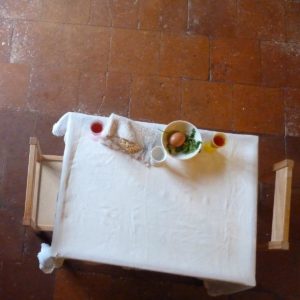
We’ve celebrated Passover in our home for a number of years now, and each year it’s different, as we adapt it around who will be there.
We tend to have a big feast-like meal interspersed with parts of the service (seder). We include elements which we use each week in our Shabbat meal, for example lighting the candles and washing hands, as well as many, but by no means all of the special Passover rituals. For a longer and more detailed service, please get hold of The Heavenly Party by Michele Guinness as she has lots of great elements to include, as well as ideas of how you can celebrate Passover in a large group at your church, or you could join my GodVenture Passover Online Workshop, a flexible, do-it-when-it works-best-for-you set of materials to explore Passover.
My Passover service sheet is designed so you can print it double-sided onto A4 paper and fold it into an A5 service sheet. You can get it here.
We sometimes send people a copy of the service sheet in advance so they have a chance to read it for themselves.
Before we start, we usually allocate different parts for different people to read/say. Our daughters have their favourite parts they like to do, and we find other people do too. I usually write people’s names beside the part they are doing so I can prompt them if necessary.
We like to take the service at a slow pace, being flexible so that people don’t get unnecessarily hungry! You can put the food in wherever you like. I’ve not put it into the service sheet, so you can choose where you pause. If you have small children or start later, you might want to eat a starter after the welcome. Or you could do the order below.
Apart from the food, the main thing to organise is the re-telling of both the Exodus and Easter stories. This can be done as simply or creatively as you’d like. The tradition is to read the whole Exodus story, which I thoroughly recommend, but maybe not during this service. So you need to find a re-told version in a children’s Bible or ask someone to re-write a version to read at this point. We’ve used the Godly Play version, which works well. It’s short and has things to watch and then play with (sand, people etc). You just need to find a way to tell these stories which will work for your gathered guests, and if possible, involve them in the telling.
With drinking, I always make sure there’s a red grape juice option for the children and others who might need a break from wine! We also use small glasses so as to make it to the end of the service! We’ve found the children love having a wine glass for their juice, so we’ve got some plastic ones for them. (They do great mini ones at IKEA).
Food-wise, there are a lot of traditional foods you could cook. (Google is your friend!) For the seder plate as it’s written here, you will need to:
1 cook a lamb shank a day or more before so you use the bone (or ask your butcher for one).
2 make charoseth. There are loads of recipes for this online. I use a date one, make it a day or two in advance and keep it in the fridge.
3 buy or make matzah. There are lots of recipes, but I particularly like the one below.
4 buy horseradish root (or sauce if you prefer), parsley, and an egg.
Matzah recipe
Mix 60ml oil, 4 tbs honey, 2 tsp salt, 3 eggs and 350ml water.
Stir in 750g flour. Pray as you knead into a stiff dough.
On a floured surface, roll out to about 5mm thick. Cut into squares. Place on a lightly greased tray, prick with a fork and sprinkle with salt. Bake at 220oC for 5-10 minutes until light brown.
Best eaten fresh and warm.
Suggested Order
Welcome
Light
Four Promises
First Cup
Eat starter
Exodus story
Seder plate
Second Cup
Eat the Main course
Easter story
Washing hands
Eating bread
3rd Cup
Eat Dessert
Fourth cup
